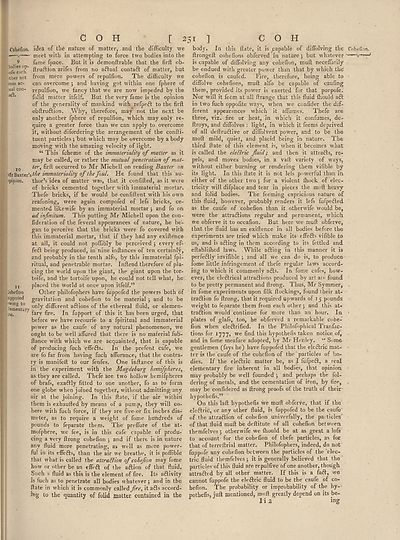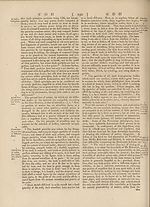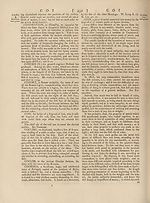Encyclopaedia Britannica, or, a Dictionary of arts, sciences, and miscellaneous literature : enlarged and improved. Illustrated with nearly six hundred engravings > Volume 6, CHI-Crystallization
(269) Page 251
Download files
Complete book:
Individual page:
Thumbnail gallery: Grid view | List view

C O H
Cohefion. idea of the nature of matter, and the difficulty we
——^— meet with in attempting to force two bodies into the
9 fame fpace. But it is demonffrable that the firft ob-
ofeearh" ftru&i°n arifes from no aftual contaff of matter, but
,ther not from mere powers of repulfion. The difficulty we
rom ac- can overcome j and having got within one fphere of
ual con- repulfion, we fancy that we are now impeded by the
folid matter itfelf. But the very fame is the opinion
of the generality of mankind with refpe6f to the firft
obftrudlion. Why, therefore, may not the next be
only another fphere of repulfion, which may only re¬
quire a greater force than we can apply to overcome
it, without difordering the arrangement of the confti-
tuent particles •, but which may be overcome by a body
moving with the amazing velocity of light.
“ This fcheme of the immateriality of matter as it
may be called, or rather the mutual penetration of mat-
10 ter, firft occurred to Mr Michell on reading Baxter on
Hr Baxter’s ^ie immateriality of the foul. He found that this au-
jpinion. thor’s idea of matter was, that it confifted, as it were
of bricks cemented together with immaterial mortar.
Thefe bricks, if he would be confiftent with his own
feafoning, were again compofed of lefs bricks, ce¬
mented likewife by an immaterial mortar j and fo on
ad infinitum. This putting Mr Michell upon the con-
fideration of the feveral appearances of nature, he be¬
gan to perceive that the bricks were fo covered with
this immaterial mortar, that if they had any exiftence
at all, it could not poffibly be perceived j every ef-
fe<5! being produced, in nine inftances of ten certainly,
and probably in the tenth alfo, by this immaterial fpi-
ritual, and penetrable mortar. Inftead therefore of pla¬
cing the world upon the giant, the giant upon the tor-
toife, and the tortoife upon, he could not tell what, he
n placed the world at once upon itfelf.”
lohefion Other philofophers have fuppofed the powers both of
uppoied gravitation and cohefion to be material j and to be
lem^ t0 on’y different adfions of the ethereal fluid, or elemen-
ire, ^ tary fire. In fupport of this it has been urged, that
before we have recourfe to a fpiritual and immaterial
power as the caufe of any natural phenomenon, we
ought to be well affured that there is no material fub-
ftance with which we are acquainted, that is capable
of producing fuch effefls. In the prefent cafe, w7e
are fo far from having fuch affurance, that the contra¬
ry is manifeft to our fenfes. One inftance of this is
in the experiment with the Magdeburg hemifpheres,
as they are called. Thefe are two hollow hemifpheres
of brafs, exa6tly fitted to one another, fo as to form
one globe when joined together, without admitting any
air at the joining. In this ftate, if the air within
them is exhaufted by means of a pump, they will co¬
here with fuch force, if they are five or fix inches dia¬
meter, as to require a weight of fume hundreds of
pounds to feparate them. The preffure of the at-
mofphere, we fee, is in this cafe capable of produ¬
cing a very ftrong cohefion ; and if there is in nature
any fluid more penetrating, as w7ell as more power¬
ful in its effefts, than the air we breathe, it is pofiible
that what is called the attraflion of cohefion may fome
how or other be an effeft of the aflion of that fluid.
Such a fluid as this, is the element of fire. Its a&ivity
is fuch as to penetrate all bodies whatever; and in the
ftate in which it is commonly called fire, it a&s accord¬
ing to the quantity of folid matter contained in the
C O H
body. In this flate, it is capable of diffolving the Cohefiart.
ftrongeft cohefions obferved in nature; but whatever '•'—■“Sr"’—
is capable of diffolving any cohefion, muft neceffarily
be endued with greater power than that by which the
cohefion is caufed. Fire, therefore, being able to *
diffolve cohefions, muft alfo be capable of caufing
them, provided its power is exerted for that purpofe.
Nor will it feem at all ftrange that this fluid fhould aft
in two fuch oppofite ways, when we confider the dif¬
ferent appearances which it affumes. Thefe are
three, viz. fire or heat, in which it confumes, de-
ftroys, and diffolves : light, in which it feems deprived
of all deftrudiive or diffolvent power, and to be the
moft mild, quiet, and placid being in nature. The
third ftate of this element is, when it becomes what
is called the eleBric fluid; and then it attrafts, re¬
pels, and moves bodies, in a vaft variety of ways,
without either burning or rendering them vifible by
its light. In this ftate it is not lefs powerful than in
either of the other two ; for a violent fhock of elec¬
tricity will difplace and tear in pieces the moft heavy
and folid bodies. The feeming capricious nature of
this fluid, however, probably renders it lefs fufpedted
as the caufe of cohefion than it otherwife would be,
were the attractions regular and permanent, which
we obferve it to occafion. But here we muft obferve,
that the fluid has an exiftence in all bodies before the
experiments are tried which make its effeCts vifible to
us, and is aCling in them according to its fettled and
eftablifhed laws. While aCling in this manner it is
perfedly invifible ; and all we can do is, to produce
fome little infringement of thefe regular laws accord¬
ing to which it commonly aCts. In fome cafes, how¬
ever, the eleCtrical attractions produced by art aie found
to be pretty permanent and ftrong. Thus, Mr Symmer, ,
in fome experiments upon filk ftockings, found their at¬
traction fo ftrong, that it required upwards of 15 pounds
weight to feparate them from each other j and this at¬
traction would continue for more than an hour. In »
plates of glafs, too, he obferved a remarkable cohe¬
fion when eleCtrified. In the Philofophical Tranfac-
tions for 1777, we find this hypothefis taken notice of,
and in fome meafure adopted, by Mr Henley. “ Some
gentlemen (fays he) have fuppofed that the electric mat- '
ter is the caufe of the cohefion of the particles of bo¬
dies. If the eleCtric matter be, as I fufpeCt, a real
elementary fire inherent in all bodies, that opinion <
may probably be well founded $ and perhaps the fol-
dering of metals, and the cementation of iron, by fire, ,
may be confidered as ftrong proofs of the truth of their
hypothefis.”
On this laft hypothefis ive muft obferve, that if the
eleCtric, or any other fluid, is fuppofed to be the caufe'
of the attraction of cohefion univerfally, the pa;tides
of that fluid muft be deftitute of all cohefion between
themfelves $ otherwife we ftiould be at as great a lofs
to account for the cohefion of thefe particles, as for
that of terreftrial matter. Philofophers, indeed, do not
fuppofe any cohefion between the particles of the elec¬
tric fluid themfelves j it is generally believed that the
particles of this fluid are repulfive of one another, though
attraCled by all other matter. If this is a fad, we
cannot fuppofe the eleCtric fluid to be the caufe of co¬
hefion. The probability or improbability of the hy--
pothefis, juft mentioned, muft greatly depend on its be-
I i 2 ing
[ 251 ]
Cohefion. idea of the nature of matter, and the difficulty we
——^— meet with in attempting to force two bodies into the
9 fame fpace. But it is demonffrable that the firft ob-
ofeearh" ftru&i°n arifes from no aftual contaff of matter, but
,ther not from mere powers of repulfion. The difficulty we
rom ac- can overcome j and having got within one fphere of
ual con- repulfion, we fancy that we are now impeded by the
folid matter itfelf. But the very fame is the opinion
of the generality of mankind with refpe6f to the firft
obftrudlion. Why, therefore, may not the next be
only another fphere of repulfion, which may only re¬
quire a greater force than we can apply to overcome
it, without difordering the arrangement of the confti-
tuent particles •, but which may be overcome by a body
moving with the amazing velocity of light.
“ This fcheme of the immateriality of matter as it
may be called, or rather the mutual penetration of mat-
10 ter, firft occurred to Mr Michell on reading Baxter on
Hr Baxter’s ^ie immateriality of the foul. He found that this au-
jpinion. thor’s idea of matter was, that it confifted, as it were
of bricks cemented together with immaterial mortar.
Thefe bricks, if he would be confiftent with his own
feafoning, were again compofed of lefs bricks, ce¬
mented likewife by an immaterial mortar j and fo on
ad infinitum. This putting Mr Michell upon the con-
fideration of the feveral appearances of nature, he be¬
gan to perceive that the bricks were fo covered with
this immaterial mortar, that if they had any exiftence
at all, it could not poffibly be perceived j every ef-
fe<5! being produced, in nine inftances of ten certainly,
and probably in the tenth alfo, by this immaterial fpi-
ritual, and penetrable mortar. Inftead therefore of pla¬
cing the world upon the giant, the giant upon the tor-
toife, and the tortoife upon, he could not tell what, he
n placed the world at once upon itfelf.”
lohefion Other philofophers have fuppofed the powers both of
uppoied gravitation and cohefion to be material j and to be
lem^ t0 on’y different adfions of the ethereal fluid, or elemen-
ire, ^ tary fire. In fupport of this it has been urged, that
before we have recourfe to a fpiritual and immaterial
power as the caufe of any natural phenomenon, we
ought to be well affured that there is no material fub-
ftance with which we are acquainted, that is capable
of producing fuch effefls. In the prefent cafe, w7e
are fo far from having fuch affurance, that the contra¬
ry is manifeft to our fenfes. One inftance of this is
in the experiment with the Magdeburg hemifpheres,
as they are called. Thefe are two hollow hemifpheres
of brafs, exa6tly fitted to one another, fo as to form
one globe when joined together, without admitting any
air at the joining. In this ftate, if the air within
them is exhaufted by means of a pump, they will co¬
here with fuch force, if they are five or fix inches dia¬
meter, as to require a weight of fume hundreds of
pounds to feparate them. The preffure of the at-
mofphere, we fee, is in this cafe capable of produ¬
cing a very ftrong cohefion ; and if there is in nature
any fluid more penetrating, as w7ell as more power¬
ful in its effefts, than the air we breathe, it is pofiible
that what is called the attraflion of cohefion may fome
how or other be an effeft of the aflion of that fluid.
Such a fluid as this, is the element of fire. Its a&ivity
is fuch as to penetrate all bodies whatever; and in the
ftate in which it is commonly called fire, it a&s accord¬
ing to the quantity of folid matter contained in the
C O H
body. In this flate, it is capable of diffolving the Cohefiart.
ftrongeft cohefions obferved in nature; but whatever '•'—■“Sr"’—
is capable of diffolving any cohefion, muft neceffarily
be endued with greater power than that by which the
cohefion is caufed. Fire, therefore, being able to *
diffolve cohefions, muft alfo be capable of caufing
them, provided its power is exerted for that purpofe.
Nor will it feem at all ftrange that this fluid fhould aft
in two fuch oppofite ways, when we confider the dif¬
ferent appearances which it affumes. Thefe are
three, viz. fire or heat, in which it confumes, de-
ftroys, and diffolves : light, in which it feems deprived
of all deftrudiive or diffolvent power, and to be the
moft mild, quiet, and placid being in nature. The
third ftate of this element is, when it becomes what
is called the eleBric fluid; and then it attrafts, re¬
pels, and moves bodies, in a vaft variety of ways,
without either burning or rendering them vifible by
its light. In this ftate it is not lefs powerful than in
either of the other two ; for a violent fhock of elec¬
tricity will difplace and tear in pieces the moft heavy
and folid bodies. The feeming capricious nature of
this fluid, however, probably renders it lefs fufpedted
as the caufe of cohefion than it otherwife would be,
were the attractions regular and permanent, which
we obferve it to occafion. But here we muft obferve,
that the fluid has an exiftence in all bodies before the
experiments are tried which make its effeCts vifible to
us, and is aCling in them according to its fettled and
eftablifhed laws. While aCling in this manner it is
perfedly invifible ; and all we can do is, to produce
fome little infringement of thefe regular laws accord¬
ing to which it commonly aCts. In fome cafes, how¬
ever, the eleCtrical attractions produced by art aie found
to be pretty permanent and ftrong. Thus, Mr Symmer, ,
in fome experiments upon filk ftockings, found their at¬
traction fo ftrong, that it required upwards of 15 pounds
weight to feparate them from each other j and this at¬
traction would continue for more than an hour. In »
plates of glafs, too, he obferved a remarkable cohe¬
fion when eleCtrified. In the Philofophical Tranfac-
tions for 1777, we find this hypothefis taken notice of,
and in fome meafure adopted, by Mr Henley. “ Some
gentlemen (fays he) have fuppofed that the electric mat- '
ter is the caufe of the cohefion of the particles of bo¬
dies. If the eleCtric matter be, as I fufpeCt, a real
elementary fire inherent in all bodies, that opinion <
may probably be well founded $ and perhaps the fol-
dering of metals, and the cementation of iron, by fire, ,
may be confidered as ftrong proofs of the truth of their
hypothefis.”
On this laft hypothefis ive muft obferve, that if the
eleCtric, or any other fluid, is fuppofed to be the caufe'
of the attraction of cohefion univerfally, the pa;tides
of that fluid muft be deftitute of all cohefion between
themfelves $ otherwife we ftiould be at as great a lofs
to account for the cohefion of thefe particles, as for
that of terreftrial matter. Philofophers, indeed, do not
fuppofe any cohefion between the particles of the elec¬
tric fluid themfelves j it is generally believed that the
particles of this fluid are repulfive of one another, though
attraCled by all other matter. If this is a fad, we
cannot fuppofe the eleCtric fluid to be the caufe of co¬
hefion. The probability or improbability of the hy--
pothefis, juft mentioned, muft greatly depend on its be-
I i 2 ing
[ 251 ]
Set display mode to:
![]() Universal Viewer |
Universal Viewer | ![]() Mirador |
Large image | Transcription
Mirador |
Large image | Transcription
Images and transcriptions on this page, including medium image downloads, may be used under the Creative Commons Attribution 4.0 International Licence unless otherwise stated. ![]()
| Permanent URL | https://digital.nls.uk/193010920 |
|---|
| Attribution and copyright: |
|
|---|
| Description | Ten editions of 'Encyclopaedia Britannica', issued from 1768-1903, in 231 volumes. Originally issued in 100 weekly parts (3 volumes) between 1768 and 1771 by publishers: Colin Macfarquhar and Andrew Bell (Edinburgh); editor: William Smellie: engraver: Andrew Bell. Expanded editions in the 19th century featured more volumes and contributions from leading experts in their fields. Managed and published in Edinburgh up to the 9th edition (25 volumes, from 1875-1889); the 10th edition (1902-1903) re-issued the 9th edition, with 11 supplementary volumes. |
|---|---|
| Additional NLS resources: |
|

